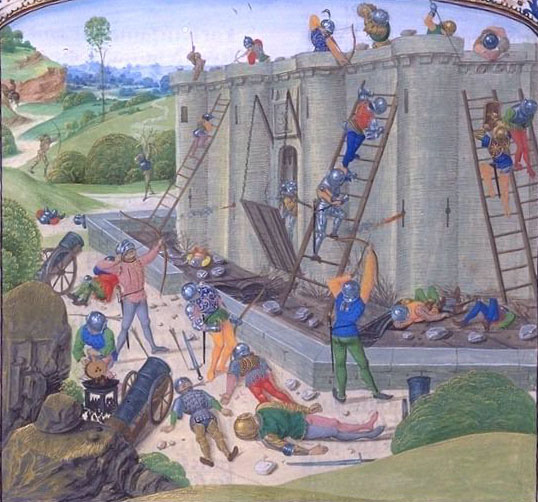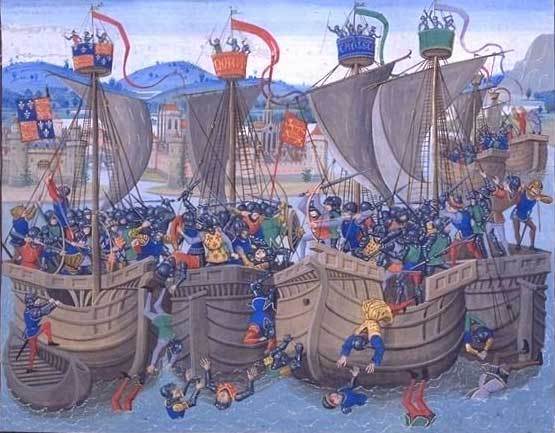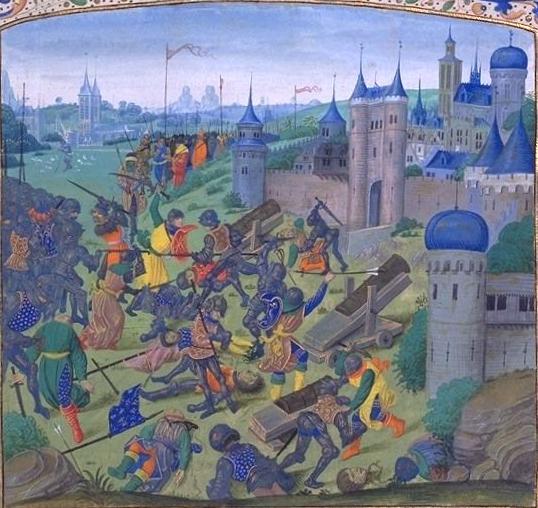
| myArmoury.com is now completely member-supported. Please contribute to our efforts with a donation. Your donations will go towards updating our site, modernizing it, and keeping it viable long-term.
Last 10 Donors: Anonymous, Daniel Sullivan, Chad Arnow, Jonathan Dean, M. Oroszlany, Sam Arwas, Barry C. Hutchins, Dan Kary, Oskar Gessler, Dave Tonge (View All Donors) |
| Author |
Message |
Craig Shira

Location: California Joined: 02 Feb 2007
Posts: 39
|
 Posted: Mon 05 Feb, 2007 8:07 pm Post subject: Historical Uses of Blued Metal Posted: Mon 05 Feb, 2007 8:07 pm Post subject: Historical Uses of Blued Metal |
 |
|
.
Hello everyone!
I have seen many sets of armor and sword hilts available that have been made blue through one process or another. One method I have been told about involves applying oil to the metal and then heating it to change the crystalline structure so that it will, to an extent, resist oxidation.
There are manuscripts that depict soldiers in armor that is a dark blue in color, which would suggest that this technique was employed on some sort of regular basis. My question is how common this process was. From what I have read, it seems to appear during the 1400's. Did it exist earlier? Was it popular in later periods? Was there a period where it was highly fashionable and then later fell out of vogue?
I imagine that the extra effort to produce blued armor would make it more costly. Yet, seeing art work where all the soldiers wear blue armor might suggest that it was more common and avaiable for wide use. This assumes that the artist hasn't taken any creative liberties with his color pallette. Does anyone know of surviving items that have been blued?
Similarly, how common would one find blued furniture on weapons? Are there many blued weapons that have been preserved? If the process was expensive, I would assume this Is something that would not be found within any mercenary, tradesman, or merchant class, correct?
Any information on the availability of bluing on weapons and armor (regardless of what time period) would be appreciated. Thank you for any leads you can provide.
(Craig)
.
|
|
   |
 |
|
Lafayette C Curtis
|
|
  |
 |
|
Lin Robinson
|
 Posted: Tue 06 Feb, 2007 4:52 am Post subject: Re: Historical Uses of Blued Metal Posted: Tue 06 Feb, 2007 4:52 am Post subject: Re: Historical Uses of Blued Metal |
 |
|
| Craig Shira wrote: | .
Hello everyone!
I have seen many sets of armor and sword hilts available that have been made blue through one process or another. One method I have been told about involves applying oil to the metal and then heating it to change the crystalline structure so that it will, to an extent, resist oxidation.
There are manuscripts that depict soldiers in armor that is a dark blue in color, which would suggest that this technique was employed on some sort of regular basis. My question is how common this process was. From what I have read, it seems to appear during the 1400's. Did it exist earlier? Was it popular in later periods? Was there a period where it was highly fashionable and then later fell out of vogue?
I imagine that the extra effort to produce blued armor would make it more costly. Yet, seeing art work where all the soldiers wear blue armor might suggest that it was more common and avaiable for wide use. This assumes that the artist hasn't taken any creative liberties with his color pallette. Does anyone know of surviving items that have been blued?
Similarly, how common would one find blued furniture on weapons? Are there many blued weapons that have been preserved? If the process was expensive, I would assume this Is something that would not be found within any mercenary, tradesman, or merchant class, correct?
Any information on the availability of bluing on weapons and armor (regardless of what time period) would be appreciated. Thank you for any leads you can provide.
(Craig)
. |
Somewhat later than the time frame I think you are discussing, but it is known that most Scottish all-metal pistols, at least those made of iron, were originally blued. Some of these guns still show traces of the original bluing. The popular image these days is that they were always polished. However, their current condition is the result of normal wear and overzealous cleaning.
Lin Robinson
"The best thing in life is to crush your enemies, see them driven before you and hear the lamentation of their women." Conan the Barbarian, 1982
|
|
  |
 |
Craig Shira

Location: California Joined: 02 Feb 2007
Posts: 39
|
 Posted: Tue 06 Feb, 2007 9:32 pm Post subject: Blue redefined Posted: Tue 06 Feb, 2007 9:32 pm Post subject: Blue redefined |
 |
|
.
The article was interesting to read but only vaguely referred to the process of bluing to which I am referring. Unfortunately, it did not answer my question. Since the bluing process has more than ornamentation value, it holds the practical reason of resisting rust, I was wondering if it was a common way of treating metal. This is not to say that blue steel will not rust, it will, but it is more resistant to oxidation than white steel. I've also heard the process referred to as blacking the metal as well.
I found on another forum a similar discussion, which brought up the published works of Jean Froissart, where people in armor are depicted. I've attached them below. It seems that blue/black armor was somewhat common, since we can see that the army is equipped with blued armor instead of plain "white" armor. A claim on that forum was made that ""until about 1440 most armour was polished steel and after that date and for the rest of the 15thC maybe 45% of it was blue, 45% bright steel and maybe 10% painted.""
Can anyone validate or debate this? I could hunt down as much period art as possible and start counting the instances of blue or black armor and the instances of blue or black sword parts and see what result I get.
I'll see what else I can find.
(Craig)
.
 Attachment: 99.89 KB Attachment: 99.89 KB

Regular armor
 Attachment: 48.26 KB Attachment: 48.26 KB

Blued armor / black armor
 Attachment: 57.14 KB Attachment: 57.14 KB

Blued armor / black armor
|
|
   |
 |
|
Lafayette C Curtis
|
 Posted: Tue 06 Feb, 2007 11:30 pm Post subject: Posted: Tue 06 Feb, 2007 11:30 pm Post subject: |
 |
|
I'm afraid the illustrations from Froissart and other contemporary works can't really help very much since the colors could have changed substantially since the original printing/painting of those illustrations--dark gray oxidizing to blue or vice versa. We can take it as some sort of evidence that blued armor did exist, but not for the relative proportions of blued to white and painted armor. Even if you count photographs of museum display pieces instead, you're still going to get a skewed demography.
So, unless somebody can refer to a book whose writer has done extensive and in-depth research on the subject, I'm afraid the most we can say is that blacked/blued, white, and painted armor existed, but not the proportions or relative popularity of each. We'd be glad, though, if somebody would willingly do this kind of research for us, since it requires a kind of investment in time and money that most of us can't afford.
(Yes, it's a sad thing that most of these resources are theoretically accessible to amateur scholars, but practically useful only to professional ones who know their job.)
|
|
  |
 |
|
Kjell Magnusson
|
 Posted: Wed 07 Feb, 2007 12:19 am Post subject: Re: Historical Uses of Blued Metal Posted: Wed 07 Feb, 2007 12:19 am Post subject: Re: Historical Uses of Blued Metal |
 |
|
| Craig Shira wrote: |
One method I have been told about involves applying oil to the metal and then heating it to change the crystalline structure so that it will, to an extent, resist oxidation. |
Sounds a bit strange, I've always understood it as creating a thin, hard oxide layer on the surface through controlled oxidisation, not a change of the crystalline structure (well, the oxide layer will probably have it's own, completely new structure, so that changes as well, but the chemical reaction would both be a more fundamental change, and the one that gives us the corrosion resistance). This layer then keeps the steel beneath isolated, thus preventing further oxidation.
|
|
  |
 |
Craig Shira

Location: California Joined: 02 Feb 2007
Posts: 39
|
 Posted: Wed 07 Feb, 2007 12:23 am Post subject: Re: Historical Uses of Blued Metal Posted: Wed 07 Feb, 2007 12:23 am Post subject: Re: Historical Uses of Blued Metal |
 |
|
.
| Kjell Magnusson wrote: | | Sounds a bit strange, I've always understood it as creating a thin, hard oxide layer on the surface through controlled oxidisation, not a change of the crystalline structure (well, the oxide layer will probably have it's own, completely new structure, so that changes as well, but the chemical reaction would both be a more fundamental change, and the one that gives us the corrosion resistance). This layer then keeps the steel beneath isolated, thus preventing further oxidation. |
Your description might be more accurate than mine. I'm new to the topic, so I doubt that my description is reliable. This too is something I am investigating.
.
|
|
   |
 |
|
Dudley Toelke
|
 Posted: Wed 07 Feb, 2007 10:34 am Post subject: Charcoal Bluing Posted: Wed 07 Feb, 2007 10:34 am Post subject: Charcoal Bluing |
 |
|
I am only familiar with the charcoal bluing process for 18th Century (and earlier) gun parts. However, the process would be the same, I believe. The process consists of cleaning the metal (degreasing), placing the part in a metal container on top of some crushed charcoal (real charcoal, not briquets), covering the part completely in crushed charcoal Then, building a fire and heating the container to a temperature that will not cause a wood splint, inserted into the charcoal in the container, to combust. The temperature is held there for two hours or less (depends on the size of the container). The metal comes out a grey to dark blue that is very rust resistant, much more than bright metal; the obvious reason for the process but it also looks great. The resulting process does create a hardening of a very thin skin on the metal and the resulting change in color.
Others use a different process but they are all pretty much the same. I have heard of just starting a charcoal fire, burying the part in the ash and then covering it completely with charcoal, pulling the part out every so often and wiping it down with linseed oil and then replacing it.
The rifle shop at Williamsburg Virginia is where I got my process from which is also the one descibed in the Journal of Arms Making Technology from the National Muzzleloading Rifle Association. Also, Eric Kettenburg (a gunsmith), www.erickettenburg.com, knows more about this process than just about anyone.
I am just getting into 17th century edged weapons, guns and armor, which is why I am at this site. I have not posted anything yet since I have not come up with questions yet. Still reading.
|
|
  |
 |
|
Dudley Toelke
|
 Posted: Wed 07 Feb, 2007 10:40 am Post subject: Charcoal Bluing Posted: Wed 07 Feb, 2007 10:40 am Post subject: Charcoal Bluing |
 |
|
|
Actually, I may be incorrect about the resulting change to the metal. I belive it is oxidation without oxygen.
|
|
  |
 |
|
|
You cannot post new topics in this forum
You cannot reply to topics in this forum
You cannot edit your posts in this forum
You cannot delete your posts in this forum
You cannot vote in polls in this forum
You cannot attach files in this forum
You can download files in this forum
|
All contents © Copyright 2003-2024 myArmoury.com — All rights reserved
Discussion forums powered by phpBB © The phpBB Group
Switch to the Basic Low-bandwidth Version of the forum
|

